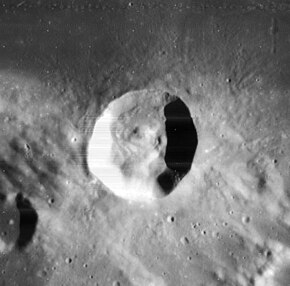Menelaus (crater)
 Lunar Orbiter 4 image | |
| Coordinates | 16°18′N 16°00′E / 16.3°N 16.0°E |
|---|---|
| Diameter | 27 km |
| Depth | 3.0 km |
| Colongitude | 344° at sunrise |
| Eponym | Menelaus of Alexandria |


Menelaus (/ˌmɛnɪˈleɪəs/) is a young lunar impact crater located on the southern shore of Mare Serenitatis near the eastern end of the Montes Hæmus mountain range. To the southwest is the small crater Auwers, and 15 km to the west-southwest is the even smaller Daubrée. To the northeast is a faint rille system named the Rimae Menelaus, near the eastern end is Tacquet crater whose distance from the homonymous crater is 80 km (less than 3 crater diameters) .
Its diameter is 27 km long and is nearly 3,000 meters deep. The area is between 500 and 550 km² and the perimeter is about 80 km.
Also, the sun rises before the third quarter of Earthshine and the sun sets before its first quarter.
Description
The wall of Menelaus is slightly irregular in outline, with a high, sharp rim and terraced inner walls. The interior has a high albedo that is prominent under high sun angles. There are several ridges on the floor. It also has a moderate ray system, with the most prominent ray aligned to the north-northeast across the Mare Serenitatis as well as the smaller crater Bessel and is rarely known as the "Bessel Ray". The location of this ray and slightly off-center central peak suggest an impact at a relatively low angle.
Names
Menelaus is named after the Greek astronomer Menelaus of Alexandria. Like many of the craters on the Moon's near side, it was given its name by Giovanni Riccioli, whose 1651 nomenclature system has become standardized.[1] Earlier lunar cartographers had given the feature different names. Michael van Langren's 1645 map calls it "Mariae Imp. Rom." after Maria Anna, the Holy Roman Empress.[2] And Johannes Hevelius called it "Byzantium (urbs)" after the city of Byzantium.[3] Also Hevelius called a feature named "Palus Inferiores" to the modern ray system of Menelaus meaning the lower marsh.
Satellite craters
By convention these features are identified on lunar maps by placing the letter on the side of the crater midpoint that is closest to Menelaus.
| Menelaus | Latitude | Longitude | Diameter |
|---|---|---|---|
| A | 17.1° N | 13.4° E | 7 km |
| C | 14.8° N | 14.5° E | 4 km |
| D | 13.2° N | 16.3° E | 4 km |
| E | 13.6° N | 15.9° E | 3 km |
The following craters have been renamed by the IAU.
- Menelaus S - See Daubrée.

Notes
References
- Andersson, L. E.; Whitaker, E. A. (1982). NASA Catalogue of Lunar Nomenclature. NASA RP-1097.
{{cite book}}: Invalid|ref=harv(help) - Blue, Jennifer (July 25, 2007). "Gazetteer of Planetary Nomenclature". USGS. Retrieved 2007-08-05.
{{cite web}}: Invalid|ref=harv(help) - Bussey, B.; Spudis, P. (2004). The Clementine Atlas of the Moon. New York: Cambridge University Press. ISBN 978-0-521-81528-4.
{{cite book}}: Invalid|ref=harv(help) - Cocks, Elijah E.; Cocks, Josiah C. (1995). Who's Who on the Moon: A Biographical Dictionary of Lunar Nomenclature. Tudor Publishers. ISBN 978-0-936389-27-1.
{{cite book}}: Invalid|ref=harv(help) - McDowell, Jonathan (July 15, 2007). "Lunar Nomenclature". Jonathan's Space Report. Retrieved 2007-10-24.
{{cite web}}: Invalid|ref=harv(help) - Menzel, D. H.; Minnaert, M.; Levin, B.; Dollfus, A.; Bell, B. (1971). "Report on Lunar Nomenclature by the Working Group of Commission 17 of the IAU". Space Science Reviews. 12 (2): 136–186. Bibcode:1971SSRv...12..136M. doi:10.1007/BF00171763.
{{cite journal}}: Invalid|ref=harv(help) - Moore, Patrick (2001). On the Moon. Sterling Publishing Co. ISBN 978-0-304-35469-6.
{{cite book}}: Invalid|ref=harv(help) - Price, Fred W. (1988). The Moon Observer's Handbook. Cambridge University Press. ISBN 978-0-521-33500-3.
{{cite book}}: Invalid|ref=harv(help) - Rükl, Antonín (1990). Atlas of the Moon. Kalmbach Books. ISBN 978-0-913135-17-4.
{{cite book}}: Invalid|ref=harv(help) - Webb, Rev. T. W. (1962). Celestial Objects for Common Telescopes (6th revised ed.). Dover. ISBN 978-0-486-20917-3.
{{cite book}}: Invalid|ref=harv(help) - Whitaker, Ewen A. (1999). Mapping and Naming the Moon. Cambridge University Press. ISBN 978-0-521-62248-6.
{{cite book}}: Invalid|ref=harv(help) - Wlasuk, Peter T. (2000). Observing the Moon. Springer. ISBN 978-1-85233-193-1.
{{cite book}}: Invalid|ref=harv(help)
External links
- LTO-42D3 Menelaus — L&PI topographic map
- Small crater at the Southern Rim of Menelaus - Lunar Reconnaissance Orbiter page - featuring the photo, an interactive photo and information
Related article
- Wood, Chuck (September 7, 2004). "Helen's Husband". Lunar Photo of the Day.
- Wood, Chuck (February 19, 2008). "Yes". Lunar Photo of the Day.
- Wood, Chuck (March 12, 2008). "Craters, Rings, Spots, and Rays During Full Moon". Lunar Photo of the Day. - includes the crater Menelaus
